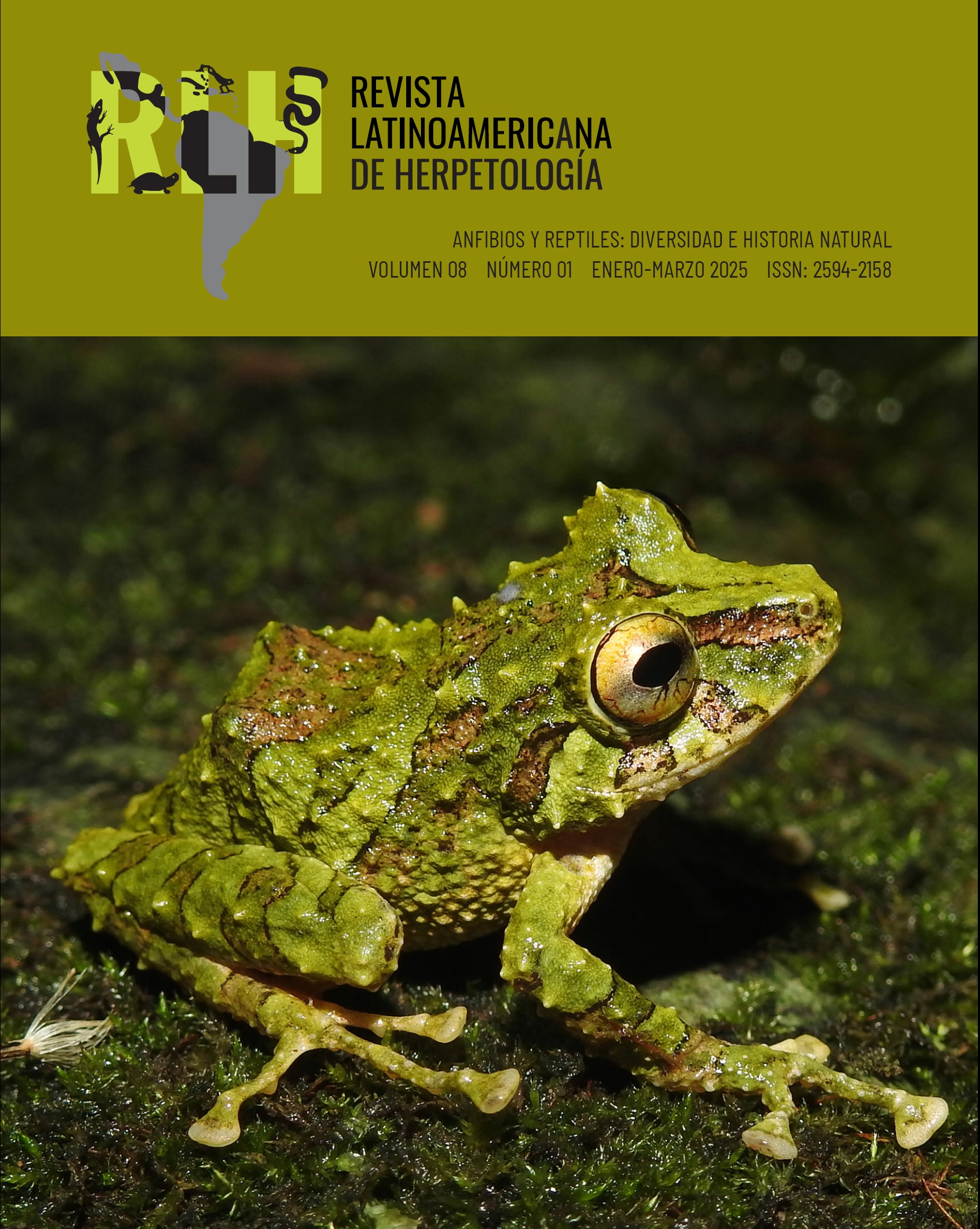RECORD OF MICOPHAGY OF Chlorophyllum molybdites (BASIDIOMYCOTA, AGARICACEAE) BY Ctenosaura pectinata (SQUAMATA: IGUANIDAE) IN PUERTO VALLARTA, JALISCO, MEXICO
DOI:
https://doi.org/10.22201/fc.25942158e.2025.1.1201Keywords:
Diet, Fungi, lizard, urban ecosystemAbstract
The first case of mycophagy in Ctenosaura pectinata, an endemic iguana species in Mexico, is reported. This species is considered Threatened by NOM-059-2010 and is known for its omnivorous diet with ontogenetic variation. However, fungal consumption had not been documented until now. This observation expands our knowledge of the species' feeding habits and significantly contributes to the scarce literature on mycophagy in lizards in the American continent.
References
Aguirre-Hidalgo, V. & R. Clark-Tapia. 2024. Mexican black spiny-tailed iguana Ctenosaura pectinata (Squamata: Iguanidae): female reproductive traits and hatchling phenotypic variability in a harvested population. South American Journal of Herpetology 31:73-81.
Ahumada-Carrillo, I.T., O. Vázquez-Huizar, J. Vázquez-Díaz & U.O. García-Vázquez. 2011. Noteworthy records of amphibians and reptiles from Zacatecas, México. Herpetological Review 42:397-398.
Ayala-Guerrero, F. & S. Huitrón-Reséndiz. 1991. Sleep patterns in the lizard Ctenosaura pectinata. Physiology & Behavior 49:1305-1307.
Ayala-Guerrero, F. & G. Mexicano. 2008. Topographical distribution of the locus coeruleus and raphe nuclei in the lizard Ctenosaura pectinata: Functional implications on sleep. Comparative Biochemistry and Physiology Part A 149:137-141.
Barraza-Soltero, I.K., F.G. Cupul-Magaña & A.H. Escobedo-Galván. 2024. Food web of lizard species in a land-bridge island from Western Mexico. Food Webs 38:e00330.
Buckley, L.J., K. De Queiroz, T.D. Grant, F.D. Hollingsworth, J.B. Iverson, S.A. Pasachnik & C.L. Stephen. 2014. A checklist of the iguanas of the world (Iguanidae; Iguaninae). Herpetological Conservation and Biology 11:4-46.
Casas-Andreu, G. 1992. Anfibios y reptiles de las Islas Marías y otras islas adyacentes a la costa de Nayarit, México. Aspectos sobre su biogeografía y conservación. Anales del Instituto de Biología, Universidad Nacional Autónoma de México, Serie Zoología 63:95-112.
Castro-Franco, R. & M.G. Bustos-Zagal. 2011. Variation in parental investment and relative clutch mass of the spiny-tail iguana, Ctenosaura pectinata (Squamata: Iguanidae) in central México. Revista Mexicana de Biodiversidad 82:199-204.
Cruz-Sáenz, D., D. Lazcano, E. Bailon-Cuellar & B. Navarro-Velázquez. 2016. Notes on the Herpetofauna of Western Mexico 15: A new food item for the Western Spiny-tailed Iguana, Ctenosaura pectinata (Wiegmann, 1834). Bulletin of the Chicago Herpetological Society 51:1-4.
Durtsche, R.D. 2000. Ontogenetic plasticity of food habits in the Mexican spiny-tailed iguana, Ctenosaura pectinata. Oecologia 124:185-195.
Elliott, T.F., D.S. Bower & K. Vernes. 2019a. Reptilian mycophagy: a global review of mutually beneficial associations between reptiles and macrofungi. Mycosphere 10:776-797.
Elliott, T.F., M.A. Jusino, J.M. Trappe, H. Lepp, G.A. Ballard, J.J. Bruhl & K. Vernes. 2019b. A global review of the ecological significance of symbiotic associations between birds and fungi. Fungal Diversity 98:161-194.
Elliott, T.F., C. Truong, S.M. Jackson, C.L. Zúñiga, J.M. Trappe & K. Vernes. 2022. Mammalian mycophagy: a global review of ecosystem interactions between mammals and fungi. Fungal Systematics and Evolution 9:99-159.
Flanigan, Jr, W.F. 1973. Sleep and wakefulness in iguanid lizards, Ctenosaura pectinata and Iguana iguana. Brain, Behavior and Evolution 8:417-436.
Flores-Villela, O. & U.O. García-Vázquez. 2014. Biodiversity of reptiles in Mexico. Revista Mexicana de Biodiversidad 85:S467-S475.
Guzmán-Huerta, G. 1977. Identificación de los hongos comestibles, venenosos, alucinantes y destructores de la madera. Limusa, Ciudad de México, México.
Johnson, J.D., V.Mata-Silva, E. García-Padilla & L.D. Wilson. 2015. The herpetofauna of Chiapas, Mexico: composition, physiographic distribution, and conservation status. Mesoamerican Herpetology 2:272-329.
Lemos-Espinal, J.A., G.R. Smith, H. Gadsden-Esparza, R. Valdez-Lares & G.A. Woolrich-Piña. 2018. Amphibians and reptiles of the state of Durango, Mexico, with comparisons with adjoining states. ZooKeys 748:65-87.
López-Ruvalcaba, O.A.L., J.L. Arcos-García, G.D. Mendoza-Martínez, R. López-Pozos, S.J. López-Garrido & L. Vélez-Hernández. 2012. Parámetros reproductivos de las hembras de iguana negra (Ctenosaura pectinata) en condiciones intensivas. Revista Científica 22:65-71.
Reid, D. A. & A. Eicker. 1991. A comprehensive account of Chlorophyllum molybdites. Botanical Bulletin of Academia Sinica 32:317-34.
Sánchez-Hernández, A.S., V.C. Rosas-Espinoza & F.A. Rodríguez Zaragoza. 2017. Canibalismo en Ctenosaura pectinata (Squamata: Iguanidae) en el parque nacional isla Isabel, Nayarit, México. Acta Zoológica Mexicana (nueva serie) 33:386-388.
Toledo, L.F., C.P.A. Prado & D.V. Andrade. 2004. Tupinambis merianae (Tegu Lizard): fungivory. Herpetological Review 35:173-174.
Uribe, M.C.A., S.R. Velasco, L.J. Guillette Jr & E.F. Estrada. 1988. Oviduct histology of the lizard, Ctenosaura pectinata. Copeia 1988:1035-1042.
Wolcott, G.N. 1924. The food of Porto Rican lizards. Journal of the Department of Agriculture of Puerto Rico 7:5-37.
Zurita-Carmona, M.E., B.C. Aguilar-Valdez, A. González-Embarcadero, G.D. Mendoza-Martínez & J.L. Arcos-García. 2009. Composición de la dieta, consumo de proteína y energía en iguana negra, Ctenosaura pectinata Wiegmann, 1834, y densidad poblacional en Santos Reyes Nopala, Oaxaca. Universidad y Ciencia 25:103-109.
Downloads
Published
How to Cite
Issue
Section
License
Copyright (c) 2025 Revista Latinoamericana de Herpetología

This work is licensed under a Creative Commons Attribution-NonCommercial-ShareAlike 4.0 International License.







